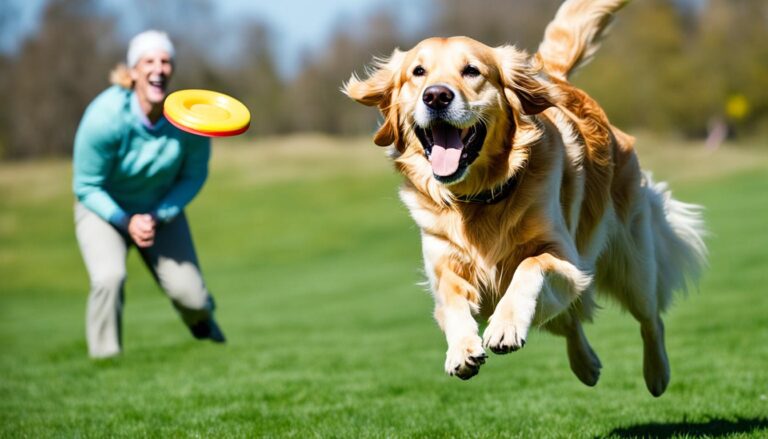How Dogs Learn To Swim | Best Tips to Learn
Ever wondered if your furry friend could be the next Michael Phelps of the canine world? Many pet owners have wondered how dogs learn to swim. Some dogs jump right in, while others seem scared of the water. Let’s explore how dogs learn to swim and the secrets behind it.

Dogs have different feelings about water, just like people do. Some breeds seem to love swimming right away. But others need a little help. Knowing how dogs learn to swim is important for pet owners. It helps with beach trips and keeping your dog safe near water.
Key Takeaways:
- Not all dogs are natural swimmers; some need training
- Breed characteristics can influence swimming abilities
- Gradual introduction to water is key for successful dog swimming lessons
- Safety equipment like life jackets can boost confidence
- Patience and positive reinforcement are essential in teaching canine aquatic skills
Understanding Canine Swimming Instincts
Dogs and water have a special bond. Some dogs love swimming, while others don’t. It’s important to know about swimming in dogs to keep them safe.
Natural Abilities: Born Swimmers or Learned Skill?
Most dogs can swim, but not all are born to do it easily. Some breeds have special features like webbed feet or coats that repel water. Other dogs might need help to feel safe in the water.
Breed-Specific Swimming Tendencies
Some dog breeds are naturally good at swimming. Labrador Retrievers, Portuguese Water Dogs, and Newfoundlands are great in the water. But, dogs with short legs or flat faces might find it harder.
| Water-Friendly Breeds | Breeds That May Struggle |
|---|---|
| Labrador Retriever | Bulldog |
| Portuguese Water Dog | Pug |
| Newfoundland | Dachshund |
The Importance of Water Safety for Dogs
Keeping your dog safe in the water is very important. Even strong swimmers can get tired or caught in currents. Always watch your dog near water and think about using a life jacket when swimming.

With patience and the right training, most dogs can learn to like swimming. Start slow, stay positive, and always put your dog’s safety first when swimming.
Preparing Your Dog for Swimming Lessons
Getting your furry friend ready for swimming is fun. Start by letting them get used to the water. Use shallow areas like kiddie pools or beach shores for this.

Use their favorite toys or treats to help them get into the water. Put these items near the water’s edge. Then, move them closer to the water to help your dog step in. Always be patient with them.
- Start with shallow water experiences
- Use positive reinforcement techniques
- Gradually increase water exposure
For pool training, think about using a special dog ramp. This makes it easy for your pet to go in and out of the pool. Always watch your dog closely to keep them safe and happy.
“The key to successful swimming lessons is building trust between you and your dog in and around water.”
Every dog learns at their own speed. Some dogs love the water right away. Others need more time. Be patient and keep trying, and soon your dog will be swimming happily!
How Do Dogs Learn to Swim: Step-by-Step Process
Teaching dogs to swim takes time and patience. Follow these steps to help your dog learn water safely and with confidence.
Introducing Your Dog to Water
Begin by letting your dog check out shallow water. Use a kiddie pool or a calm lake shore. Give them treats and praise when they dip their paws in.
Supporting Your Dog in Shallow Water
When they’re ready, go to a bit deeper water. Hold your dog’s belly with your hand or arm. This makes them feel safe as they learn to float and paddle.
Encouraging Natural Swimming Motions
As they get more confident, help them swim by guiding their swimming motions. Let them paddle on their own but be there to support them. Praise them to make them like swimming more.
Gradually Increasing Water Depth
As your dog gets better, slowly go to deeper water. Always be close and help when they need it. Use toys or treats to get them to swim a little further.
| Step | Duration | Key Focus |
|---|---|---|
| Water Introduction | 1-2 days | Building comfort |
| Shallow Water Support | 2-3 days | Floating and balance |
| Swimming Motions | 3-5 days | Proper paddling technique |
| Deeper Water Practice | 1-2 weeks | Confidence and endurance |
Every dog learns at their own speed. Be patient and keep teaching them to swim for the best results.
Essential Equipment for Dog Swimming Training
Training your dog to swim needs the right gear. Let’s look at the must-have items for safe and effective swimming skills.
Dog Life Jackets: Choosing the Right Fit
A well-fitted life jacket is key for your dog’s safety in the water. Look for adjustable straps and buoyant materials. Measure your dog’s chest and length to find the perfect size. A snug fit means your pup stays afloat while learning to swim.
Floating Toys and Training Aids
Use floating toys to make swimming fun for your dog. Waterproof fetch toys help build swimming skills through play. Consider long-rope toys for guiding your dog in the water without getting too close. These aids make swimming lessons fun and engaging for your furry friend.
Pool Ramps and Exit Strategies
Safe exits are key when teaching dogs to swim. Install a sturdy ramp with a non-slip surface to help your dog climb out easily. Teach your pup to use the ramp with treats. Clear exit points prevent exhaustion and boost confidence in the water.
- Non-slip pool steps
- Visible pool edges
- Easy-to-spot exit markers
With the right equipment, you’ll create a safe place for your dog to learn swimming. Remember, patience and positive reinforcement are key to developing strong swimming skills.
Overcoming Common Challenges in Dog Swim Training
Dogs swimming training can be tough. Many pet owners struggle to teach their dogs to swim. Let’s look at common problems and how to fix them.
Many dogs are scared of water. They might hesitate or feel anxious near it. Start with shallow water and give them treats and praise as they get closer to the edge.
Some dogs don’t want to go into deep water. Increase the water depth slowly during training. Use a dog life jacket for safety and confidence. Give them toys or treats to encourage them to go deeper.
Getting over a fear of water takes time and patience. Make swimming fun and rewarding for your dog. Short training sessions are better than long ones that tire them out.
| Challenge | Solution |
|---|---|
| Fear of water | Gradual exposure, positive reinforcement |
| Reluctance to enter deep water | Use of life jacket, gradual depth increase |
| Difficulty with swimming techniques | Guided practice, supportive equipment |
Every dog learns at its own speed. Be patient and supportive during training. With time and effort, most dogs can become confident swimmers. They’ll enjoy the water as much as we do.
Advanced Swimming Techniques for Dogs
Once your dog knows how to swim, it’s time for more. These techniques will make swimming fun and improve your dog’s skills. Let’s learn how to make your dog better in the water.
Building Endurance and Strength
To make your dog swim longer, start with short times and increase them. Begin with 5-minute swims and aim for 15-20 minutes. Add water treading exercises to strengthen their core. This keeps them swimming right for longer times.
Teaching Different Swim Strokes
Dogs swim with a paddle stroke, but you can teach them more. The breaststroke-like stroke saves energy. Show them how to move their front paws in circles. Give them treats and praise when they do it right.
Water Retrieval Games and Exercises
Fun games make swimming better and keep your dog’s mind sharp. Try these activities:
- Fetch with floating toys
- Underwater retrieval (with supervision)
- Relay races with multiple dogs
These games mix fun with learning, making swimming lessons fun and useful. Always keep your dog safe and watch how much they play during these sessions.
| Exercise | Benefits | Duration |
|---|---|---|
| Water Treading | Builds core strength | 2-3 minutes |
| Long-Distance Swim | Improves endurance | 10-15 minutes |
| Underwater Retrieval | Enhances breath control | 5-7 minutes |
Conclusion
Teaching your dog to swim is fun and rewarding. With patience and the right steps, your furry friend can learn to swim. Not all dogs are born swimmers, but they can learn with your help.
Always put safety first when teaching your dog to swim. Use life jackets and start in shallow water. Never leave your pet alone near water. Keep training short and fun to help your dog feel safe.
Swimming is great for exercise and bonding with your dog. This guide will help you teach your dog to swim. It’s a skill that can make your dog’s life better for fun, fitness, or safety.
FAQ
Are all dogs natural swimmers?
Not all dogs are born swimmers. Some breeds like retrievers and water spaniels love water. But, many dogs need to learn how to swim.
How do I acclimate my dog to water?
Begin by letting your dog get used to water in kiddie pools or shallow ponds. Give them treats for staying calm near the water. This helps them feel safe.
At what age can I start teaching my puppy to swim?
You can start swim training with puppies at 12-16 weeks old. But, make sure they’re okay with the water first. Don’t rush them into deep water.
Should I use a life jacket when teaching my dog to swim?
Yes, use a life jacket for swim lessons. It helps them stay afloat and feel safe in the water.
How can I overcome my dog’s fear of water?
Let your dog set the pace. Don’t push them into the water. Use treats and praise to help them feel good about the water. You might want a pro to help too.
What are some water-friendly dog breeds?
Dogs like Newfoundlands, Portuguese Water Dogs, Golden Retrievers, Labrador Retrievers, and Irish Water Spaniels are great swimmers.
How can I build my dog’s swimming endurance?
Begin with short swims and slowly add more time as they get stronger. Try water games and fetch to make it fun.
What safety precautions should I take when teaching my dog to swim?
Always watch your dog in the water. Make sure they can get out easily. Use a dog life vest or flotation device. Never leave them alone near water.
Subscribe to our weekly newsletter below and never miss the latest article.









